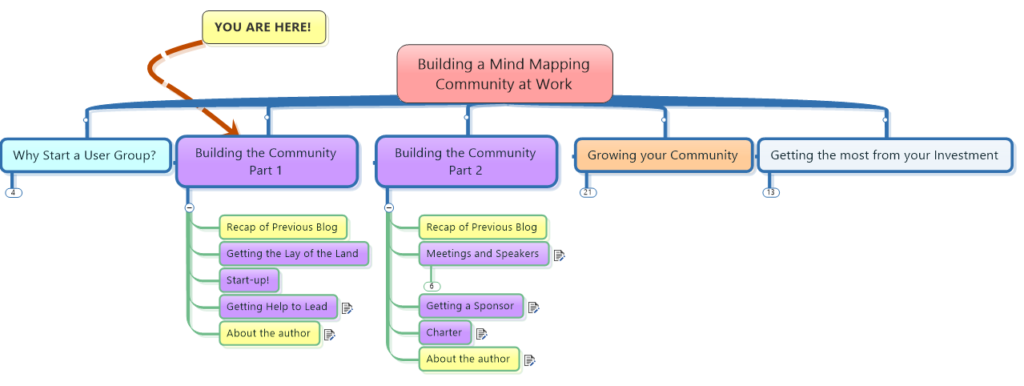By: David Halverson (Guest Blogger)
This is the second in a series of blog posts discussing the topic of building a mind mapping community within your company. You can read his full series by clicking on the links below:
- Why Start a Mind Mapping User Group?
- Building a Mind Mapping Community – Part 2
- Growing Your Mind Mapping Community

As the name implies, a community of mind mappers is a group of employees that have been exposed to mind mapping and wish to further their personal skills or promote mind mapping within their company.
In our first blog, we:
- Defined the term ‘Mind Mapping Community’.
- Discussed reasons that you might want to start a community at your workplace.
- Suggested the types of people that may want to join your community.
- Outlined the value that such a community brings to you and your company.
- Discussed practical considerations before you start.
If you haven’t already, you may want to read the first blog post to provide context for this one.
Get the Lay of the Land in Your Workplace

Previously Mindjet’s Customer Success Manager
Worked at The Boeing Company for 30 years
Before you decide if you want to start a mind mapping group, you may want to gather information about the environment at your workplace:
- Does your company have a policy of supporting communities? If so, what are the rules? Is there a mechanism for community support such as allowing the use of meeting rooms, conference calling, persuasion of your management or even some financial support for box lunches or your travel if required?
- Regardless of company policy, is your management likely to support your efforts? Some companies will allow you to spend 10% of your time for such activities. However, some managers want your focused attention so you may have to pursue your mind mapping journey after working hours.
- Does your workplace have an intranet where you can advertise your meetings?
- What is the geographic spread of your company? Are you in one location or scattered? If you are all in one place, you can use face-to-face meetings. If your company is large and in multiple locations, you may have to resort to teleconferencing or a service such as Skype.
- Do you have people around you that are also interested in mind mapping that you can seed your community with and draw support from?
- Are there organizations in your company that use mind mapping or have been exposed to it? Are there other communities that could complement your mind mapping community that may have similar interests?
- Do you have an executive sponsor in mind? You may need a sponsor to offer support and guidance to you as you grow your organization. More on this later.
- Do some introspection about your motivations, determine if you have the time and skills to run a community.
Starting to Build Your Community
If, after your initial investigation, you feel that it’s still looking good to start a community, you’ll want to get some things lined up:
- Determine the people with whom you will start your community. They may be willing to help you lead or they may want to just attend your meetings. Either way, get an email distribution going and let them know what’s up often.
- Have a meeting with your start-up helpers to get their input on frequency of meetings, type of meetings (telecon or face-to-face), purpose of the community and what you hope to accomplish. You might also want to ask everyone if they know of good speakers or other potential members for the community. Be sure to listen to your team, as they will have good ideas. You’re a leader now even though you may not have managerial control. This is a great exercise in building a team without direct authority.
- Build a charter for your group listing objectives, defining roles of the leadership of the community, target membership, relationships with supporting organizations or people and generally describing your community as a whole.
- Develop an ‘elevator’ pitch that can be used to give someone a good description of your community in 30 seconds. It should be sweet and to the point such that they may want to support or even join.
- Get a sponsor. Your sponsor should be an executive with some clout and, of course, some interest in seeing your community successful.
- Sign-up for any company sponsored support given to communities such as you are building. They will probably have some rules but may also help you advertise your community and meetings.
Getting Help From Your Team
You only have so much time to work on your community so you will need helpers to expand your capability. Find out who in your network is familiar with mind mapping and who would be willing to help. Ask them face-to-face for their assistance in working on your community. Blanket emails requesting help don’t work. No one will step up because emails are too impersonal and everyone thinks that someone else will do it. Here’s some first steps to build your team:
- Talk to your potential helpers in person (or on the phone if that is not possible) about their interests, capabilities and available time. Remember that some of the busiest people are also the most capable.
- Don’t be hasty in your team selection as it is far better to be under-staffed than fully staffed with team members that are just not right for your community.
- Match their capabilities and interests with your requirements. This is a basic staffing technique.
- Give your new helpers some small tasks to perform and see what happens. If they are successful, you will want to expand their responsibilities.
- Unfortunately, very few people will feel as strongly about the success of the community as you do. If you talk to any community leader, they will tell you that, often, the leader ends up with doing much of the work. That’s O.K. Just spread the praise around as much as possible and see if your team will grow into their jobs.
- The more that you spread the work around, the stronger and more committed your team members become.
- Listen to your team and take them seriously. Once you get other people involved, your community starts to become a community and your plans will need to be flexible to accommodate.
Up Next in the Series: Maintaining Your Community
In the next blog post, I will discuss issues associated with starting and maintaining a mind mapping related community. These concepts are transferable to other types of communities as well, of course.
We will discuss fundamentals as you start-up your community, meetings and speakers, getting a sponsor and developing a charter for your group.
Talk soon!
About the Author:
Dave Halverson has teamed up with Jamie Nast, creator of Idea Mapping and internationally known trainer of over 25,000 students to offer a one-day course titled ‘Idea Mapping Using MindManager’.
Dave was previously Mindjet’s Customer Success Manager and worked for 30 years at The Boeing Company as a systems analyst, business analyst and project manager for various Boeing divisions. He was President and Director of the N/W Electronic Commerce Roundtable and 8 years ago started the Boeing Mind Mapping Interest Group which grew from a dozen members to over 600. He has also taught business at Bellevue College and City University in Bellevue Washington. Dave can be contacted at blackdiamondmind@gmail.comor Jamie through her website.

